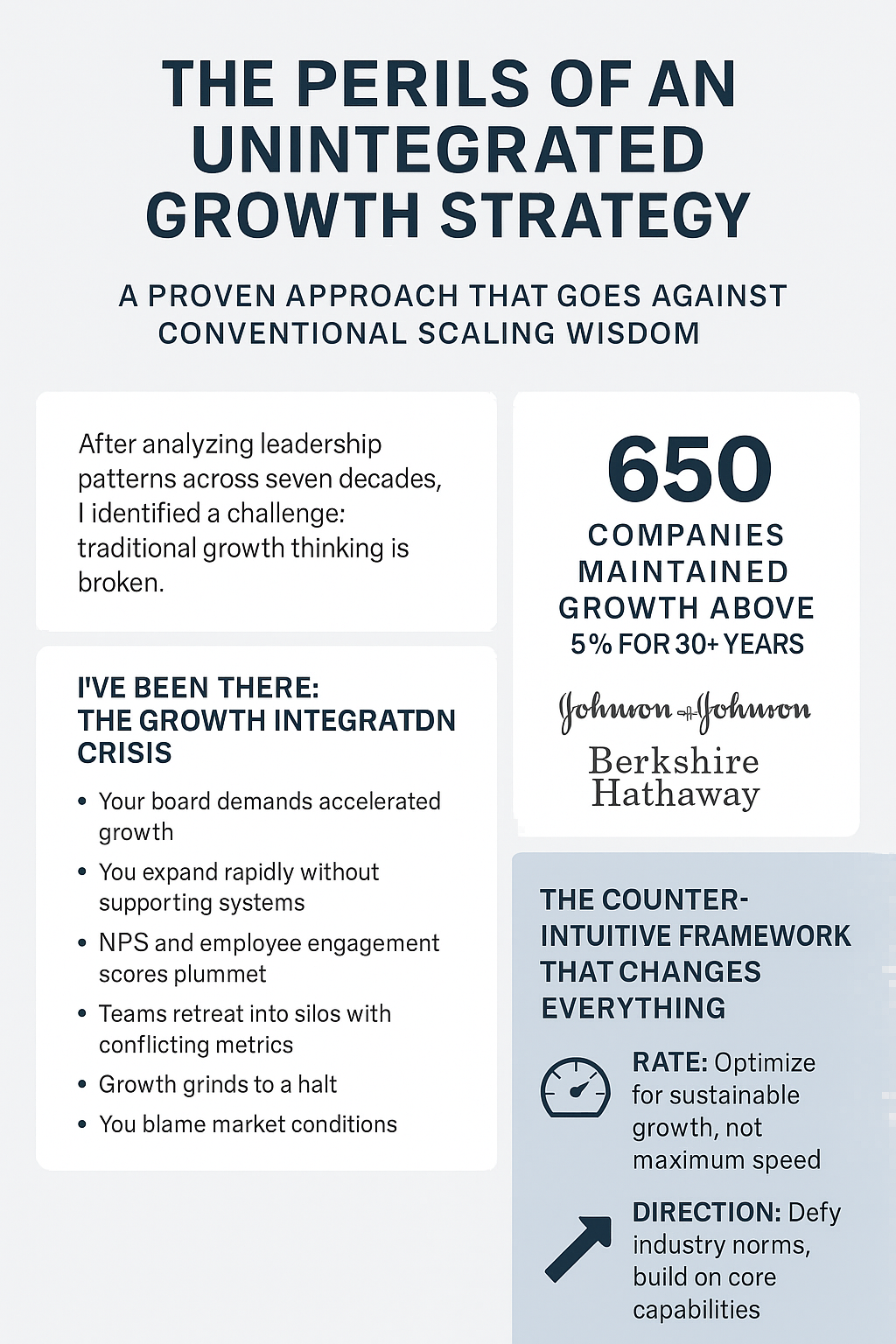
A Proven Approach That Goes Against Conventional Scaling Wisdom
Let me share something I’ve learned the hard way: Despite what most advisors tell you, maximum growth speed isn’t your goal. Integration is.
After working with hundreds of leaders across tech, manufacturing, healthcare, and financial services, I’ve seen a pattern that challenges traditional thinking. When I analyzed 11,000 companies across seven decades, the data revealed something shocking: only 650 companies maintained growth above 5% for over 30 years. Just seven companies—including Johnson & Johnson and Berkshire Hathaway—stayed in the top performance quartile throughout the entire study.
In today’s uncertain economy, this matters more than ever. Companies facing inflation pressures and talent shortages are especially vulnerable to what I call in Business Breakthrough 3.0 “the subconscious mind of the business”—those underlying patterns driving behavior that can sabotage your growth strategy.
I’ve Been There: The Growth Integration Crisis
You’ve probably lived this scenario: Your board demands accelerated growth → You expand rapidly without supporting systems → Your NPS and employee engagement scores plummet → Teams retreat into silos with conflicting metrics → Growth grinds to a halt → You blame market conditions.
When I led New Relic’s transformation as EVP/GM during a similar economic climate, pushing 40% year-over-year (YoY) revenue growth, we discovered something crucial: growth without integration creates measurable “organizational debt” that shows up in three critical KPIs:
- Customer retention rates drop by 15-30%.
- Employee productivity decreases by 20-25%.
- New initiative implementation times double or triple.
At Web.com, scaling from zero to IPO and $500M+ in revenue, I watched this debt compound until our EBITDA margins were threatened. The conventional wisdom of “grow at all costs” nearly sank us.
The Counter-Intuitive Framework That Changes Everything
Through these real-world battles, I developed what I call the RDM framework—an approach that often contradicts what most growth advisors suggest:
Rate: How fast can you grow without breaking things? While competitors chase maximum growth, Pal’s Sudden Service maintains one error per 3,600 orders (versus the industry’s one per 15) by tying growth directly to manager development capacity. Their restraint looks like weakness to outsiders, but delivers 3x higher profit per location.
Direction: Where should you point your growth efforts? In SaaS, we’re told to expand offerings. In manufacturing, it’s geographic expansion. But I’ve seen companies thrive by doing the exact opposite of conventional wisdom—Walmart by doubling down on core markets, Johnson & Johnson through targeted diversification. What matters isn’t following industry norms, but building from your distinctive capabilities.
Method: How will you fuel this growth? In today’s capital-constrained environment, Southwest Airlines’ approach is instructive. They achieved 12.3% CAGR (beating the industry’s 10.5%) not through external funding but by developing operational capabilities competitors couldn’t replicate—a lesson most C-suites miss.
Here’s the leadership insight that changed everything for me: These three decisions must be made by the same leadership team, in the same room, as an integrated system—not delegated to separate departments with competing incentives.
Four Actions You Can Implement This Quarter
Having navigated both high-growth environments as COO at Blameless and EVP at New Relic, as well as complex integrations through 35+ M&As, I’ve identified four leadership actions that deliver immediate results:
- Create a cross-functional growth council with real decision-making power. Typical cross-functional teams lack authority. Instead, form a council with P&L responsibility that meets weekly with a focused agenda: identifying integration constraints before they become visible in financial results. Track the “constraint identification lead time” as your key metric here.
- Implement a growth absorption dashboard that balances speed with capability. Most executive dashboards track growth metrics exclusively. Create a balanced scorecard that pairs each growth metric with its corresponding capability metric: sales growth vs. onboarding capacity, market expansion vs. support infrastructure, feature releases vs. quality indicators. The gaps between these paired metrics predict future problems.
- Make joint RDM decisions in your next leadership meeting. Bring your CFO, COO, and CRO together to make rate, direction, and method decisions in concert. Ask: “If we succeed in A, can we actually deliver B with method C?” I’ve watched both startups and Fortune 500 companies transform once they stopped making these decisions in separate meetings.
- Institute quarterly strategic recalibrations with this specific agenda: “What capabilities do we need to build before accelerating further?” When leading digital transformation across multiple $1B+ brands at Cox Automotive during market uncertainty, these capability-focused sessions prevented the margin erosion most of our competitors experienced.
The Hard Truth About Sustainable Growth in Today’s Economy
After decades leading growth organizations through multiple economic cycles, here’s the contrarian insight I’ve validated repeatedly:
“The companies that deliberately slow growth to build capabilities during uncertainty outperform those that maximize growth rates during the same period.”
While most companies chase market share and growth at all costs during economic pressure, the real winners temporarily moderate growth to build capabilities that enable them to accelerate rapidly when conditions improve.
As a senior leader, your most important skill isn’t maximizing growth—it’s integrating your rate, direction, and method decisions into a coherent system